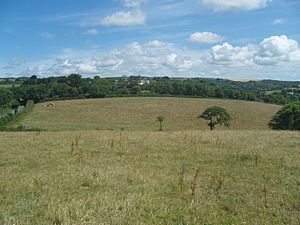Battle of Stratton facts for kids
Quick facts for kids Battle of Stratton |
|||||||
|---|---|---|---|---|---|---|---|
| Part of the First English Civil War | |||||||
 Site of the Battle of Stratton, c. 2010 |
|||||||
|
|||||||
| Belligerents | |||||||
| Commanders and leaders | |||||||
| Sir Ralph Hopton Sir Bevil Grenville Sir Nicholas Slanning |
Earl of Stamford James Chudleigh |
||||||
| Strength | |||||||
| 2,400 foot 500 horse 8 guns |
5,400 foot 200 horse 13 guns |
||||||
| Casualties and losses | |||||||
| 90 dead | 300 dead 1,700 captured |
||||||
The Battle of Stratton, also known as the Battle of Stamford Hill, happened on May 16, 1643. This important battle was part of the First English Civil War. During the fight, the Royalists, who supported King Charles I, defeated the Parliament's army in the areas of Devon and Cornwall.
Contents
Why the Battle Happened
England Divided: Royalists vs. Parliament
The English Civil War was a big conflict in England. It was fought between those who supported King Charles I (called the Royalists) and those who supported Parliament (called the Parliamentarians). Different parts of England supported different sides.
When the war began, Cornwall mostly supported the Royalists. However, Devon and Somerset mainly supported Parliament. Both areas had people who disagreed with the main side.
Leaders of the Armies
In July 1642, King Charles I put the Marquess of Hertford in charge of his army in the west of England. Sir Ralph Hopton was his second-in-command.
For Parliament, the Earl of Stamford took command of their army in the West Country in January 1643. He chose James Chudleigh as his main helper.
Parliament's Plan to Attack
In April, James Chudleigh captured some letters. These letters showed that Sir Ralph Hopton was planning to join forces with other Royalist leaders in Somerset.
The Earl of Stamford wanted to stop this. He decided to attack Hopton's army before they could get stronger. Stamford gathered the biggest army he could. He pulled soldiers from Parliament's forts in Devon and brought in more from Somerset.
Setting the Stage at Stratton
To trick the Royalists, Stamford sent most of his cavalry (horse soldiers) on a fake attack. This group, led by Sir George Chudleigh, attacked the Royalist fort at Bodmin. This made it harder for Hopton to get more soldiers from Bodmin.
Stamford's plan seemed to work. Hopton could only gather about 2,400 foot soldiers and 500 horse soldiers. Stamford's army was much larger, with 5,600 soldiers.
On May 15, Stamford and his Parliamentarian army arrived at Stratton. Stamford placed his foot soldiers along the top of a long, rectangular hill. They faced southwest, ready for a fight.
The Battle of Stratton
The Royalist Attack Begins
The battle started early on May 16, at 5:00 am. Sir Ralph Hopton decided to attack the hill from four different places at the same time. Each attack group had 600 foot soldiers and 2 cannons.
- Hopton himself led the first group from the southeast.
- Francis Bassett led a second group from the northwest.
- Sir Bevil Grenville and Sir Nicholas Slanning led the other two groups. They attacked from the southwest.
This way, the Royalists focused their strength on specific points of the long Parliamentarian line. Behind these four attacking groups, the Royalist cavalry waited in reserve.
Fierce Fighting on the Hill
The fighting was very close and lasted for eight hours. Both sides fought bravely. At one point, the Royalist soldiers started running low on ammunition.
Parliamentarian soldiers, armed with long spears called pikes, charged at Grenville's group. Grenville was knocked down, and his soldiers were shaken. But then, Sir John Berkeley's musketeers (soldiers with guns) counter-attacked. They stopped the Parliamentarian charge and began to push them back up the hill.
Royalist Victory
Even though they were outnumbered, the Royalist soldiers kept pushing forward. They reached the top of the hill before 4:00 pm.
At this point, the Parliamentarian army broke apart and ran away. The Royalists had won! About 300 Parliamentarian soldiers died in the battle. The Royalists also captured 1,700 Parliamentarian prisoners. The Royalists had much fewer losses, with only about 90 men killed.
What Happened Next
After the battle, James Chudleigh was captured. He then decided to switch sides and joined the Royalists.
The Earl of Stamford retreated first to Barnstaple, then to Exeter. He blamed Chudleigh for the defeat. George Chudleigh also stopped his attack on Bodmin and returned to Exeter.
In the end, Sir Ralph Hopton had secured Cornwall for King Charles. Within a few days, he also took control of most of Devonshire. This battle was a big win for the Royalists in the west of England.

